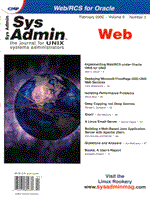
Questions and Answers
Jim McKinstry
root 139 1 0 Oct 18 ? 0:00 /usr/sbin/inetd -s/inetd is the Internet Services Daemon for UNIX. It controls all of the TCP/IP (i.e., telnet, ftp, etc.) connections into your machine. The services it handles are defined in /etc/inetd.conf. Check it out for more information. Then, do a ps -ef | grep telnet, and you'll see something like:
root 15185 139 0 16:17:06 ? 0:00 in.telnetd You may see more than one in.telnetd running, but they will all have the parent process (third column of the output) of “139” (or whatever your inetd PID is from the first ps command). Next, do a ps -ef | grep 15185, where “15185” is the PID of your in.telnetd process, and you'll see something like:
root 15185 139 0 16:17:06 ? 0:00 in.telnetd root 15187 15185 0 16:17:06 pts/5 0:00 -ksh You'll see that your login shell (ksh in this case) was spawned by the in.telnetd session. In a nutshell, this is how a telnet connection works to a UNIX system -- a remote user telnets to the UNIX box. On the UNIX box, the inetd daemon (only one) receives the incoming request on port 23. inetd takes the request and checks the /etc/inet/services file to see what to do with it. /etc/inet/services has an entry like:
telnet 23/tcp This says that any request received on port 23 is a telnet request. inetd then checks /etc/inetd.conf where there is a line like this:
telnet stream tcp nowait root /usr/sbin/in.telnetd in.telnetd This basically says that if inetd receives a telnet request, then spawn /usr/sbin/in.telnetd. When you look at your NT system, you will not see an inetd or telnetd process running. NT does not provide (at least through revision 4.0) a telnetd service. The telnetd (the telnet daemon) for NT is available from third parties. A good one is NFS Maestro Package from Hummingbird Communications Ltd. The package provides a myriad of inetd style services and a full telnet and ftp daemon, as well as the ability to mount NFS shares.
dd if=<input file> of=<output file> For example, to copy a whole disk (HP-UX) to tape: dd if=/dev/rdsk/c0t3d0 of=/dev/rmt/0m To copy a whole disk (Solaris) to tape:
dd if=/dev/rdsk/c0t3d0s2 of=/dev/rmt/0m To copy a whole disk (HP-UX) to another disk: dd if=/dev/rdsk/c0t3d0 of=/dev/rdsk/c0t4d0 To copy a whole disk (Solaris) to another disk:
dd if=/dev/rdsk/c0t3d0s2 of=/dev/rdsk/c0t4d0s2
root:qQ5vhs6JFddRA:10830:::::: To remove the password, delete the qQ5vhs6JfddRA, and the line will look like:
root::10830:::::: If using only /etc/passwd the the root entry looks something like:
root:ciMwPzD28pGE2:0:3::/:/sbin/sh To remove the password, delete the ciMwPzD28pGE2 and the line will look like:
root::0:3::/:/sbin/sh
lrwxrwxrwx 1 root root 48 Jun 4 15:19 /dev/dsk/c0t0d0s2 -> ../../devices/ sbus@2,0/QLGC,isp@1,10000/sd@0,0:c The information that uniquely identifies this device is:
"sbus@2,0", "QLGC,isp@1,10000" and sd@0,0 Now look in /etc/path_to_inst for this device. /etc/path_to_inst records mappings of physical device names to instance numbers. Type:
"grep sbus@2,0 /etc/path_to_inst | grep QLGC,isp@1,10000 | grep sd@0,0” and you see:
"/sbus@2,0/QLGC,isp@1,10000/sd@0,0" 0 "sd" The format is: “physical name”, instance number, and “driver binding name”. Notice that this device is “driver binding name” sd, and “instance number” 0, for a name of sd0. Below is a script that will calculate this information for you. I've tested it on Solaris 2.5.1 and 2.6, but you may need to tweak it a little. It does not handle pseudo devices.
#!/bin/ksh
# Print out ssd and sd devices and their /dev/dsk/c?t?d?s2 counterparts.
# EX: ssd0 is /dev/dsk/c0t0d0s2
# Loop through each disk device in /dev/dsk.
for DEVICE in 'ls /dev/dsk/c*t*d*s2'
do
# for each device, grab some info that will uniquely identify the
# device in the /etc/path_to_inst
ls -l $DEVICE | awk -F'/' '{ print $7, $8, $NF }' | read info1 info2
info3
# Now grab the "driver binding name" ("sd" or "sdd") field and the
# "instance number"
grep $info1 /etc/path_to_inst | grep $info2 | grep 'echo $info3
| awk -F':' '{ print $1 }' '
| awk '{ print substr($3,2,(length($3)-2))$2 }' | read SD_DEVICE
# Now print out the results
echo $SD_DEVICE is $DEVICE
done
Another solution is to install Rich Pettit's SymbEL Tools (RICHPse, RICHPsex, and ANCrules). Located in the example directory, /opt/RICHPse/examples, is a program called disks.se that will convert the names for you. Use /opt/RICHPse/bin/se disks.se to run it. The only problem is that this tool seems to only recognize disks with mounted filesystems on them. There are many other tools included in these packages that seem useful and should be examined. You can get these packages at:
http://www.sun.com/sun-on-net/performance/se3/
About the Author
Jim is a Technical Analyst specializing in UNIX. He has worked for IBM, Rite Aid, EDS, and is currently working for Sprint Paranet. He can be reached at: jrmckins@yahoo.com.
|